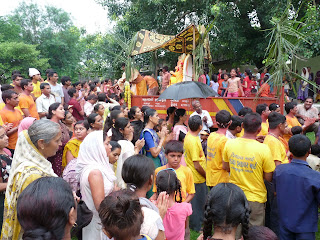


Ganesh festival is a celebration for a Hindu God called Ganesha, who is also known in the west as the Elephant-Headed God. Ganesha is the son of one of the three main Hindu Gods called Shiv. Before I talk about the festival, I would like to introduce Ganesha and his importance in the Hindu world. There are many religious stories on how Ganesha received his elephant head; I will share the one I grew up with. Shiv, Ganesha’s father use to travel a lot to the mountains when Ganesha was growing up so Ganesha was very attached to his mother. One day Parvati, Ganesha’s mother went to take a bath. She told Ganesha to guard the door from outside and not let anyone in. Shiv came there and asked Ganesha to let him in. Ganesha refused. Shiv is known as the God of destruction. He is known for his anger. Shiv didn’t take no for an answer and he cut Ganesha’s head. Parvati came out and found her son dead. She told Shiv to bring her son back to life unless she will use her special powers to destroy everything. Shiv couldn’t replace Ganesha’s head and bring him back to life with the same head, so they decided to wait for the first thing that passes in certain direction to cut its head. An elephant passed and so Shiv cut that elephant’s head and performed the rituals to replace Ganesha’s head. Parvati was very concerned about her son’s future with the elephant head. She took a promise from shiv that in the mortal world, Ganesha should be prayed first on any occasion, and Ganesha should come before any God. Even today, Ganesha is prayed to before any other major Hindu Gods or Goddesses. Ganesha resides on a mouse, he has a big belly and he loves ladoos (an Indian sweet made of wheat flour, sugar, cinnamon, almonds etc…)


Ganesh festival is usually celebrated for 5 to 10 days. A group of people or a community comes together and builds a booth in which a big Ganesh Idol is placed. These idols are ordered months in advance. In Bajipura there were about 6-8 Ganesha booths. On the first day of the festival a ritual for calling the great Ganesha to come and reside in these booths were performed. After the initial rituals, each morning and evening for all 10 days prayers performed at these booths. On the last day there was a closing ceremony where the idols were taken to the river bank and dispersed in the water. Dispersing depends on the auspicious day and time the Brahmin (the highest Hindu caste) priest has suggested.




In Bajipura, it was really good to see the whole community come together every night. Each booth had something special going on. Some prayed with classical music in the background, some did Garba (Gujarati folk dance) and some had feasts. My Hindu students enjoyed this festival a lot. Every day in class my students would invite me to go see their Ganesha after school. “Teacher, please come to our Ganesha we will play carrom.”Carrom is an Indian board game which my students enjoyed playing during this festival. After going to various different Ganesha booths every night, I realized that it wasn’t just a festival for children; it was rather a learning experience. Parents allowed children to be out till late because they wanted their children to see how everything is arranged so that in future they can carry this tradition forward. It wasn’t just time to play and chill; it was a lot more than that. Along with my students, this festival was a very unique learning experience for me too. I can’t wait to come back to India in future to celebrate this festival again.





No comments:
Post a Comment